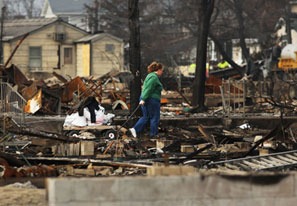
My family has lived in the New Dorp Beach section of Staten Island since 1945. In July 2008, my husband and I purchased a 768-square-foot brick ranch house on Topping Street, a half block from the ocean. We survived Hurricane Irene in 2011 with only minimal damage to our basement and property. The next year, as Superstorm Sandy approached, I expected that we’d make out fine. My husband knew better.
The night Sandy hit, my mother, daughter, and I stayed with my brother at his house in Pleasant Plains, an inland neighborhood. Our main concern was flooding. Most of the men in our neighborhood returned to their homes to run the pumps and try to keep their houses dry. My husband did the same, and early in the evening, he called to say that there wasn’t a drop of water in the basement. When he called again 15 minutes later, he was out of breath and clearly shaken. “Babe, it’s over,” he said. A storm surge had swept through with such force that the water initially passed over an opening to our cellar without going in. He had been forced to run for it, grabbing our dog and bolting for the car. When he arrived at my brother’s house, he and the dog were soaked.
Finally, a reason to check your email.
Sign up for our free newsletter today.
The scene in my neighborhood the next day was one of complete devastation. We tracked through knee-high water down an alley. Boats and cars blocked the main roads. The air smelled like ocean, raw sewage, and diesel fuel. The wood-frame houses had been pancaked to the ground. Only splinters remained. Our house still stood, thanks to the bricks, but everything in it had been destroyed.
The days that followed were filled with confusion and despair. With the exception of the NYPD and FDNY, no disaster-recovery agencies came around for three days, not even the Red Cross. It was just us, our neighbors, and thousands of volunteers. The challenges were enormous. Most of us had lost everything we’d worked for all our lives. We had to find places to live while cleaning out what remained of our houses and watching DSNY haul it away. When FEMA finally arrived, they asked me for paperwork that I couldn’t give them—it had been destroyed. They directed me to other agencies that required more of the same, with a form for everything and a booklet of forms to follow up on the first form.
President Obama showed up on Topping Street two weeks after the storm. He told me that he would cut through the red tape and make sure that my neighbors and I would get what we needed to rebuild. “FEMA works for me,” he said. I believed him that day, but he didn’t deliver on his promise.
The first six months after Sandy were filled with mixed signals and bureaucratic miscommunication. When all you have is the clothes on your back, you’re forced to rely on family, friends, and volunteers. We happen to be fortunate on Staten Island. Our elected officials didn’t just sit in their offices. They got out on the streets and assessed the situation. Not all New York boroughs can say that.
Before the storm, we did everything by the book. We had flood insurance and homeowners insurance. In the end, it didn’t do us much good. Who knew that insurance companies paid out for rebuilding according to national averages, not local property values? I could have built a beautiful home in Kentucky with what we were paid, but I couldn’t afford to buy a condo in New York City. Dealing with the insurance companies was an eye-opener, as it always is. So was dealing with New York City’s Build It Back program, which is supposed to help people like me rebuild. For a long time, no one at BIB knew what they were doing. I frequently had to resubmit forms due to the city’s negligence or ignorance. The BIB program has been through three directors since its launch in summer 2013. The program has improved, but it has a long way to go.
We returned to our house on Topping Street 33 months after the storm. Our little brick house is now flanked on either side by zombie properties. The empty lots and boarded-up houses in my neighborhood are like missing teeth, a constant reminder of Sandy’s destruction. Three years after the storm, some of my neighbors are still waiting to see a shovel put in the ground to start their rebuilding. Some will never return home. That’s what hurts the most.
I’m often asked, “How does it feel to be home?” My answer: “We’re okay, but we’ll be great once our neighbors come back.” The next time something like this happens, we’ll learn from the mistakes that were made after Sandy.